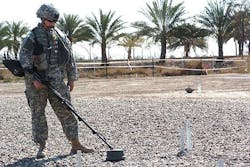L-3 CyTerra to build mine-detection systems with ground-penetrating radar to find non-metallic explosives
Officials of the Army Contracting Command at Aberdeen Proving Ground, Md., announced plans this week to award a sole-source contract to L-3 CyTerra for as many as 1,800 upgrade kits to enable the AN/PSS-14 to detect non-metallic threats and near-surface buried wires.
These kits would upgrade the AN/PSS-14A and AN/PSS-14B models to the AN/PSS-14C. AN/PSS-14B is designed to locate a variety of metallic and low-metallic mines. The AN/PSS-14C is the latest model, with all the functionality of the AN/PSS-14B, but with additional functionality to detect non-metallic threats and near-surface buried wires.
The upcoming contract to L-3 CyTerra will be for 1,800 AN/PSS-14 Rev 4 to Rev 6 upgrade kits that will enable the upgrade of the AN/PSS-14 A and B models to the AN/PSS-14C. Upgrades also will enhance the system's performance, reliability, maintainability and sustainment.
Related: DARPA awards three contracts to detect IEDs hidden in mud, meat, and dead animals
The value of the upcoming contract has yet to be negotiated. The upgrade of the actual AN/PSS-14 systems will be done by personnel at the Tobyhanna Army Depot in Tobyhanna, Pa.
The AN/PSS-14 handheld standoff mine detection system combines a ground-penetrating radar, sensitive metal detector, and advanced data fusion algorithms. This enables the system to detect anti-personnel and anti-tank mines, and to reject metallic clutter to lower the system's false-alarm rate. The AN/PSS-14 went into full-rate production as the Army’s standard mine detector in 2006.
The system's ground-penetrating radar is based on a wideband coherent stepped frequency radar transceiver. The search head contains one transmit and two receive antennas. The transmit antenna produces a continuous-wave low power radar signal.
As the search head passes over the ground its radar waves strike a discontinuity in the soil and reflect back to the receive antennas and to on-board signal processing.
Related: Army to evaluate Israeli-designed vehicle-mount sensors suite to detect and pinpoint IEDs
The system's advanced metal detector coil surrounding the diameter of the sensor head creates an electromagnetic field that induces an electrical current in any metal object buried in the soil. The sensor head detects this secondary electromagnetic field and responds with an alarm.
Data fusion algorithms enable the operator to discriminate between metallic clutter and actual mines. These algorithms are based on terrain modeling using a real-time novelty methodology. As the operator advances, the terrain model updates continuously to adapt automatically to varying soil conditions.
For more information contact L-3 CyTerra online at http://cyterra.com/index.htm, or the Army Contracting Command at Aberdeen Proving Ground at http://acc.army.mil/contractingcenters/acc-apg.
Ready to make a purchase? Search the Military & Aerospace Electronics Buyer's Guide for companies, new products, press releases, and videos
